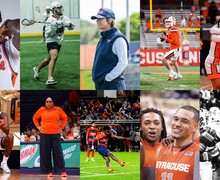Expanding his presence: Fair plans to build on successful freshman season by broadening his role
C.J. Fair
UPDATED: Nov. 13, 2011, 11:34 p.m.
The 3-pointer from the corner against Cal State-Los Angeles provided a peek at the past and future for C.J. Fair.
Last year, it would have been completely unorthodox for the 6-foot-8 Fair to confidently bury a shot from long range. He attempted just three 3s as a freshman, making only one.
‘I hit my first 3 and missed my next two,’ Fair said. ‘And I had to stick with what I knew I could do. My time was limited, so I didn’t want to keep trying.’
But flashback a few more seasons — to his time playing AAU basketball for the Baltimore Stars — and the story of Fair’s jump shot is quite different.
‘His jump shot? C.J.’s always had a jump shot,’ said Antonio Barton, a current Memphis guard and Fair’s former AAU teammate. ‘I’d like to see him shoot more now that he’s in college. When he was little, C.J. was one of the best shooters on our team.’
The rare triple from Fair in SU’s first exhibition game Nov. 1 — which brought his mother to her feet in the stands — showcased the beginning of the jump shot’s rebirth. Following a freshman season in which Fair played 18.6 minutes per game and earned his time through strong rebounding and defense, he enters the 2011-12 season with the goal of expanding and unleashing more of his offensive game for the No. 5 Orange.
The egoless Fair did only what the coaching staff asked of him as a freshman, and, as a result, his minutes increased throughout the season. That fostered a sense of belief in the then-19-year-old forward. And it’s something that pushed him toward a productive offseason.
‘I earned my way into it,’ Fair said. ‘Going into this year, that gave me confidence in myself. I feel more comfortable out there. And this year I can start out with a bang.’
Rediscovering that 3-point stroke is a big part of Fair’s plan. During his first three years of high school, which were played at Baltimore City College (Md.) High School, Fair said he was known as a jump shooter. But a torn anterior cruciate ligament in 11th grade forced him to lose a full year of basketball.
Lost, too, was the shooter’s mentality. When he returned for his senior year, after transferring to Brewster Academy in New Hampshire, Fair subconsciously transformed into more of a slasher.
‘I came back and I don’t know what got into me, but I started being a driver,’ Fair said. ‘So I had to try and get the shooting back.’
It was the focus of his work during the summer, both in Syracuse and at home in Baltimore, with the goal of extending his shooting range by the time he arrived back on campus. At home he trained with a family friend as well as the Barton brothers — the aforementioned Antonio and his brother, Will, who also plays at Memphis.
All shooting, all the time.
‘Repetition, repetition, repetition,’ Fair said. ‘Until I couldn’t even lift my arms.’
The results are ‘unbelievable,’ SU assistant coach Adrian Autry said. Head coach Jim Boeheim went so far as to label it a ‘two-fold’ improvement.
The better jump shot brings Fair closer, yet also distances him further from teammate James Southerland. Both are 6-foot-8 forwards who straddle the line of small forward and power forward. Both competed for playing time off the bench last season.
Southerland’s strength has always been on the offensive end — a silky shooter with touch from beyond the 3-point arc. Defense and rebounding are his downfall.
For that reason, Fair’s and Southerland’s minutes developed an inverse relationship. Last year’s Syracuse team didn’t need more offense. It needed a defensive spark that could rebound and exude toughness.
‘When you’re out there and play extended minutes, you’re going to have to contribute,’ SU graduate assistant Gerry McNamara said. ‘That’s just the bottom line. If you’re going to be on the floor, you’re expected to do that. There were times last year where James didn’t rebound at a high rate last year and C.J. did. And I think that affected how the minutes played out.’
There’s no better example than last year’s crushing loss on the road at Pittsburgh.
Without star forward Kris Joseph, who was out with a concussion, Syracuse needed one of its bench players to emerge as a viable contributor. Fair and Southerland both played in excess of 35 minutes, but their stat lines read like opposites.
Southerland scored eight points and grabbed but a single rebound. Fair exploded for what was then a season-high of 16 points and hauled in nine rebounds, five of which came on the offensive end of the floor.
It was this game, despite the loss, that made Joseph realize his ‘little brother’ could be the next dominant swingman down the road for the Orange.
‘I saw flashes of it in the nonconference,’ Joseph said. ‘But definitely, definitely after that Pitt game he knew that he belonged. He stepped up, and since then, I saw him go up. I never saw him step back after that game.’
From that game forward, Fair scored in double figures six times and grabbed seven or more rebounds six times as well. Southerland never reached double figures the rest of the season, nor did he grab more than three rebounds in a game after the loss to Pittsburgh.
Fair is adamant that Joseph has the starting small forward spot locked down for the upcoming season. But his length and versatility on offense and defense have him eyeing the starting power forward position left vacant by the departure of Rick Jackson.
It’s a position that requires him to rebound consistently — like he did last year — while also defending bigger opponents.
Jason Smith, who coached Fair at Brewster, said that shouldn’t be an issue. On a team with ‘seven or eight’ future Division-I players, there was a three-week period when Smith opted for a smaller lineup.
Fair and current Iowa State forward Melvin Ejim, who is 6 feet 6 inches, were the two frontcourt players. And Fair was expected to rebound and defend like a center. He never complained, Smith said, and had a slew of games with 12, 13 or 14 rebounds.
‘A lot of kids get caught up in positions — I’m a 2, I’m a 3, I’m a 4 — but I don’t think C.J. lets any of that stuff bother him,’ Smith said. ‘His mental approach to the game is fantastic. He understands he’s a basketball player and that he can do many different things.’
And the retooling of his jump shot represents the newest thing Fair can do on the court. Whether he earns a starting spot is yet to be seen, but when addressing Fair’s role Boeheim made it clear that this year’s Syracuse team would have less of a distinction between starters and players coming off the bench.
Duane Davis, his former AAU coach, saw Fair a few times in the summer and noticed a different demeanor from the sophomore. Autry also saw it when Fair arrived on campus.
He’s jumping again — bouncing off the floor — now fully recovered from that ACL injury. And with an increased confidence on the heels of a successful freshman year, his past coaches and everyone in the SU program is expecting a dynamic sophomore season.
‘Sit back and watch,’ Davis said. ‘He’s going to be something to see. If his confidence level is back where it was before his knee injury, he’s going to be fine.
‘I think he’s going to have a hell of a year at Syracuse this year. A breakout year.’
Published on November 9, 2011 at 12:00 pm
Contact Michael: mjcohe02@syr.edu | @Michael_Cohen13





